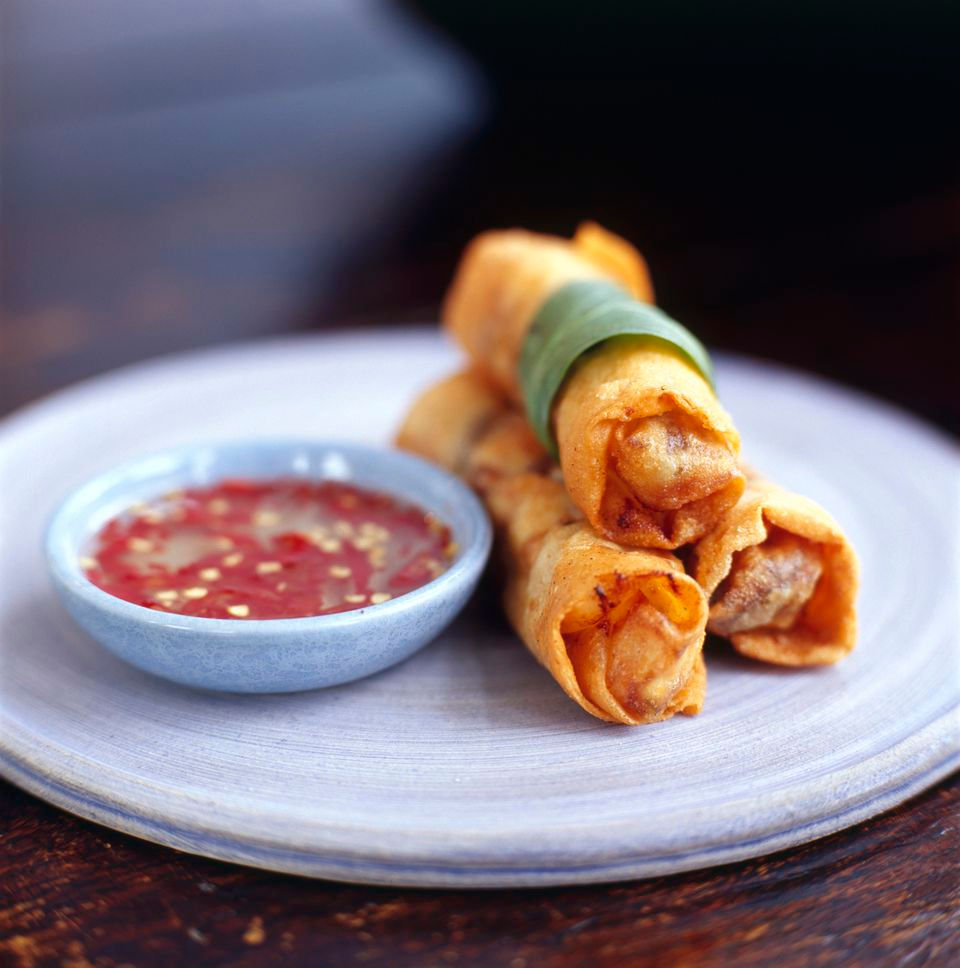VIETNAMESE CUISINE
- Tu Pham
- Nov 26, 2017
- 7 min read
Part 1: COMMON DISHES IN VIETNAM

Food plays an important role in Vietnamese culture. Vietnamese cuisine has no complicated points. Many of the most popular dishes can be served in both a luxury restaurant or on the side of the road. Although the food is not sophisticated, it still requires a lot of ingredients. Sometimes just missing out a small ingredient can ruin the flavor of the dish.
In general, Vietnamese cuisine is the combination of five fundamental tastes, representing five elements in the nature: Sour symbolizes Wood, Bitter symbolizes Fire, Sweet symbolizes Earth, Spicy symbolizes Mental, and Salty symbolizes Water. Not only that, seasoning is also an indispensable ingredient to make an unforgettable dish. Most of dishes in Vietnam is the mixture of arrange of flavor and tastes such as fish sauce (nước mắm), herbs (lemongrass, spring onion, garlic chives, Thai basil, hot mint, coriander, etc.), hot chilli, and black pepper.
Traditional cake: Bánh Chưng and Bánh Dày (Square Sticky Rice Cake and Round Sticky Rice Cake)
The legend of Square Sticky Rice Cake and Round Sticky Rice Cake.
The name and source of these cakes originate from a fairy tale in Vietnam. For a long time ago, when “Hung Vuong”, a King of Viet Nam, grew old and he knew that soon it would be time to pass his kingdom on to his successor. The only trouble was that the King had three healthy sons, and he did not know who would be the best choice. He called his three sons together and said: “I would like each of you to provide for me a dish of food. You must search for the ingredients, make the dish and serve it to me on the last day of this Lunar Month. On the basis of this dish, I will decide who is to be the ruler of our Kingdom”. Within days, the two elder brothers had organized their servants and horses and carriages and were racing all over Vietnam and even to other parts of South East Asia to find the most delectable and delicious ingredients for the dish.
By the end of the Lunar Month, each of the brothers had prepared their dishes and came before the whole of the Vietnamese royal court and their wise father Hung Vuong to present it. The first brother came to the father and presented a fine porcelain dish of flying fish dressed in a sweet chili sauce accompanied by expensive lotus seeds. A hush came over the court as the father viewed the dish and placed it on the table. The second brother came forward, and he opened a large copper cauldron and presented a dish of boar dressed with wild mushrooms and a rare wild fern sauce. Again, all the court watched the father place the cauldron on the table. Then Prince Tiet Lieu came forward and opened his basket and displayed a large flat rice cake. The court and his brothers gasped! No one would dare offer such simple fare to the royal of The King.
Hung Vuong said, “Prince Tiet Lieu, tell me why you have chosen to present me with such a simple rice cake”.
Prince Tiet Lieu said, “Rice is the most precious and valuable of all food found in this kingdom, yet it is also the most abundant. I have prepared a dish that represents my love for you and our beautiful Vietnam. I have cooked it thoroughly then molded it into a round rice cake, and called it Bánh Dày, as it symbolizes the sky we live under. I have cooked a square rice cake, stuffed it with cooked bean paste and ground meat in the middle and called it Bánh Chưng. This will symbolize the earth we live on”.
Since the prince became The King, people usually make two kinds of cake on the Lunar New Year's Day to worship their ancestors.

Three main ingredients to make Bánh Chưng (Square sticky rice cake)

Bánh Chưng in Lunar New Year’s Day

Bánh Chưng in Lunar New Year’s Day
Phở (Vietnamese beef noodle soup)
No matter what time day or night, you can easily find a dish of Phở - a popular and well known in Viet Nam. This national staple is made with flat rice noodles, a warming broth and usually chicken or beef. The flavor of this comforting noodle soup can vary greatly across the country, and many establishments load your table with sauces, herbs and spices so you can season your pho exactly how you like it. In each region of Vietnam, people will add their signature herb ingredients and that will bring a different flavor to the dish.

Phở served with lemon, green vegetables, bean sauce, and chilli sauce
Bánh Xèo (Crispy Vietnamese pancake/ pizza)
Besides Phở, Bánh Xèo – known as Crispy Vietnamese pancake or sizzling cake – is also a famous food which is widely believed to originate from France during its occupation of Vietnam. The word “xèo” depicts the sizzling sound when pouring the rice batter into the hot skillet.

Main ingredients to make Bánh Xèo
This “Vietnamese pancake” has a yellow outer layer and is filled with boiled pork strips, shrimp, bean sprouts and spring onion. Though some people might prefer to use chopsticks to directly eat Bánh Xèo, the best way to enjoy it is eating with your hands. First, take a piece of Bánh Xèo and put it on the rice paper. Add fresh vegetables that are always served with the dish (there’re a lot of vegetables to choose, but lettuce, Vietnamese perilla, basil and bean sprouts are the most common) and roll them tightly. With each bite, don’t forget to dip the roll into the sauce – the spirit of this dish.

How to eat Bánh Xèo in the right way
I am sure that right after the first bite, the impressive taste of crunchy crust, savory fillings, sweet and sour dipping sauce will definitely make you fall in love with this delicacy. Besides, the sauce is a perfect blend of spices (including fish sauce, sugar, lime juice, garlic and chilli), while the herbs help eliminate the greasy taste.
Each region across this S-shaped country has its own unique ingredients and flavours to make Bánh Xèo become one of its specialties. In Southern Vietnam, Bánh Xèo is in the size of a large dish and its outer layer is also yellow. In Central Vietnam, the dish is white and much smaller. As for Hanoi, the preparations of Bánh Xèo are similar to those in the south, but include special fillings like slices of Indian taro and green mango. Perhaps because of those differences, not only Vietnamese people but also foreigners may find it hard to resist the attraction of a crispy, messy but colorful combination all consisted in Bánh Xèo.
Rolls dishes
Chả giò (Vietnamese Crispy Spring Rolls)
There is a dish that can be served all year round, and present in almost every menu of Vietnamese restaurant abroad: A dish that is so famous that many locals of Vietnam assume it as their own specialty and give it their own name such as: “Nem Rán” by northerners and “Chả Giò” by southerners.

Ingredients used for the fried spring roll are different depending each local but usually it comprises of lean minced pork, sea crabs or unshelled shrimps, edible mushroom, dried onion, duck/chicken eggs, pepper, salt and different kinds of seasoning.

Whichever they are, all ingredients are mixed thoroughly before being wrapped with rice paper into small rolls. These rolls are then fried in boiling oil. The cooked rolls are usually garnished with fresh lettuce and herbs.
(As an aside, fried spring rolls are called Nem in the north and Chả Giò in the south … just in case you didn’t think the Vietnamese language was confusing enough.)
Phở Cuốn (Fresh Rice Noodle Rolls)
Originated from the worldly famous “Phở” – Vietnamese rice noodle soup, “Phở Cuốn” is a fresh and tasty dish that has become a part of Hanoi cuisine in the last two decades.
According to stories, there was one street vendor at the corner of Ngu Xa and Nguyen Khac Hieu Street in Hanoi which sold traditional Vietnamese Phở for diners who were watching football late in the evening. One day, the broth ran out and there were some uncut noodles left. Therefore, to satisfy the hunger of customers, the man invented a new dish. He pressed the noodles like rice paper roll and then added the beef into the roll with herbs. When served, the rolls were dipped in the Vietnamese dipping sauce with sugar, vinegar, water, garlic and fish sauce. Surprisingly, the visitors were interested in this new food. After that, the shop changed to new style of Phở.

The taste of Phở Cuốn is completely different with Traditional Phở. Even they both have same noodles, beef and herbs, the taste of Phở Cuốn when using it with fish sauce is unique and new. There is one secret there that the host has a special in marinating meat and mixing the fish sauce.
If you like eating the traditional Vietnamese Food Phở , why do not try another special style of it once time. Take a note on your diary trip before coming to Vietnam to make sure you will not forget one of amazing dishes here.

Innovated Phở Cuốn with many color from vegetables
Bánh Cuốn (Vietnamese Steamed Rice Rolls)
Bánh Cuốn looks like a soft spring roll, filled with a mixture of pork, onions, wood ear mushrooms, and fish sauce. It tastes delicious and the ingredients are actually common foods. For those are familiar with Bánh Cuốn, it become favourite breakfast food. For those have not yet ever try the dish, once taste it, you soon fall in love with its flavor.

A dish of Bánh Cuốn is usually served with fresh vegetables, Vietnamese pork sausage, and dipping sauce.
To make Bánh Cuốn, they ladle each scoop of the rice flour-based batter onto the steamer, covering it with a lid for a matter of seconds, then carefully transferred the gossamer-thin sheets with a bamboo stick onto a tray to be filled with minced mushrooms and pork.

Steamed rice roll cooked on a pot, covered by thin fabric, until it is very thin.

The roll is filled with a mixture of pork, wood ear mushrooms, onion


























Comments